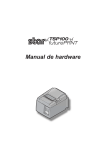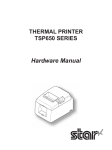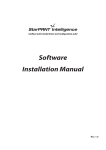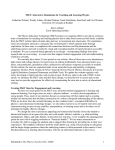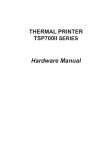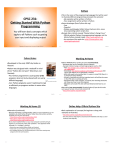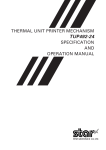Download User's Manual DP8340II SERIES [Parallel]
Transcript
Dot Matrix Printer DP8340 Series [ PARALLEL INTERFACE ] USERS Manual Federal Communications Commission Radio Frequency Interference Statement This equipment has been tested and found to comply with the limits for a Class A digital device, pursuant to Part 15 of the FCC Rules. These limits are designed to provide reasonable protection against harmful interference when the equipment is operated in a commercial environment. This equipment generates, uses and can radiate radio frequency energy and, if not installed and used in accordance with the instruction manual, may cause harmful interference to radio communications. Operation of this equipment in a residential area is likely to cause harmful interference in which case the user will be required to correct the interference at his own expense. For compliance with the Federal Noise Interference Standard, this equipment requires a shielded cable. This statement will be applied only for the printers marketed in U.S.A. Statement of The Canadian Department of Communications Radio Interference Regulations This Class A digital apparatus complies with Canadian ICES-003. Cet appareil numérique de la classe A est conforme à la norme NMB-003 du Canada. The above statement applies only to printers marketed in Canada. Trademark acknowledgments DP8340: Star Micronics Co. Ltd. Notice • All rights reserved. Reproduction of any part of this manual in any form whatsoever, without STAR’s express permission is forbidden. • The contents of this manual are subject to change without notice. • All efforts have been made to ensure the accuracy of the contents of this manual at the time of going to press. However, should any errors be detected, STAR would greatly appreciate being informed of them. • The above notwithstanding, STAR can assume no responsibility for any errors in this manual. © Copyright 1986-2008 Star Micronics Co., Ltd. TABLE OF CONTENTS 1. Outline............................................................................................ 1 2. Unpacking and Installation.............................................. 2 2-1.Unpacking.............................................................................................. 2 2-2.Installation of Paper Holders and Re-Roll Prevention Guard (Only Model DP-8340FC)................................................................... 3 2-3.Handling Care....................................................................................... 4 2-4.Maintenance.......................................................................................... 5 3. Part Identification and Nomenclature...................... 6 3-1.Power Supply Unit................................................................................ 6 3-2.Printer.................................................................................................... 7 3-3.Part Functional Description................................................................ 8 4. Installation of Ink Ribbon and Paper........................... 9 4-1.Installation of Ink Ribbon................................................................... 9 4-2.Removal of Ink Ribbon...................................................................... 10 4-3.Paper Insertion.................................................................................... 11 4-3-1. Model DP8340FC.........................................................................11 4-3-2. Model DP8340SC.........................................................................12 4-4.Paper Removal.................................................................................... 13 5. Control Codes.......................................................................... 14 6. General Specifications........................................................ 16 7. Interface ..................................................................................... 20 7-1.Interface Specifications...................................................................... 20 7-2.Interface Timing................................................................................. 20 7-3.Connectors and Signals..................................................................... 21 7-4.Setting of DIP Switches...................................................................... 22 7-5.Peripheral Unit Drive Circuit............................................................ 23 7-6.Emergency Suspension...................................................................... 23 8. Character Code List.............................................................. 24 9. Font List........................................................................................ 33 10. When power is supplied by the user............................. 46 1. OUTLINE The DP8340 series of serial dot matrix printers is for use in ECR, POS, electronic instruments, banking machines and computer peripheral equipment. The DP8340 series include the following features; 1) 2 color printing (Red and Black) 2) High-speed bidirectional printing (2 line/sec, 40 columns per line) 3) 9-pin print head 4) Parallel interface (Centronics compatible) 5) Commands for expanded characters, inverted characters, emphasized characters, and red and black printing are provided, which makes the printer very versatile. 6) Simultaneous Data Communication and Printing 7) 2 Peripheral Drivers Model Name Notation DP8340 F C Interface C: Parallel Interface Paper Feed F: Friction Type S: Sprocket Type – – 2. Unpacking and Installation 2-1. Unpacking After opening the box, check if all necessary accessories are included. (A) Printer 1 Printer 2 User’s Manual 3 Paper Holders 4 Re-Roll Prevention Guard 5 Ink Ribbon 6 DIP Switch Cover (B) Power Supply Unit (Option: PS8340A) 1 1 Power Supply Unit 2 User’s Manual Figure 2-1. Unpacking – – 2-2.Installation of Paper Holders and Re-Roll Prevention Guard (Only Model DP8340FC) Install the Paper Holders in the outermost holes in the rear of the printer. Figure 2-2. Installation of Paper Holders Install the Re-Roll Prevention Wire in the holes of the printer cover. Twisting the Wire as shown in the figure below, will make the installation easier. Figure 2-3. Installation of Re-Roll Prevention – – 2-3. Handling Care 1. Be careful not to drop paper clips, pins or other foreign matter into the unit as these cause the printer to malfunction. 2.Do not attempt to print when either paper or ribbon cartridge is not located in the printer, otherwise the print head can be damaged. 3.Do not open the cover while printing. 4.Do not touch the print head immediately after printing as it gets very hot. 5.Use only roll paper that is not glued to the core. 6. When the paper end mark appears on the paper, replace the roll paper before it runs out. WARNING PShut down your equipment immediately if it produces smoke, a strange odor, or unusual noise. Immediately unplug the equipment and contact your dealer for advice. PNever attempt to repair this product yourself. Improper repair work can be dangerous. PNever disassemble or modify this product. Tampering with this product may result in injury, fire, or electric shock. PDuring and immediately after printing, the area around the print head is very hot. Do not touch it, as you could be burned. CAUTION P We recommend that you unplug the printer from the power outlet whenever you do not plan to use it for long periods. Because of this, you should locate the printer so that the power outlet it is plugged into is nearby and easy to access. P If the voltage shown on the label on the of your printer does not match the voltage for your area, contact your dealer immediately. P Make sure that the printer is turned off and unplugged from the AC outlet and that the computer is turned off before making connections. P Do not connect a telephone line into the modular connector. PDo not pull out paper while the printer cover is closed. PIf liquids, foreign objects (coins and paper clips), and so on enter the printer, turn off the printer, unplug it from the AC outlet, and contact your dealer for advice. Continued use could cause a short circuit, which may result in fire or electric shock. – – 2-4. Maintenance Essentially, your printer is a robust piece of equipment, but should be treated with a modicum of care in order to avoid malfunctions. For example: 1.Keep your printer in a “comfortable” environment. Roughly speaking, if you feel comfortable, then the environment is suitable for your printer. 2.Do not subject the printer to physical shocks or excessive vibration. 3. Avoid over-dusty environments. Dust is the enemy of all precision mechanical devices. 4. To clean the exterior of the printer, use a cloth barely dampened with either water with a little detergent or a little alcohol, but do not allow any liquid to fall inside the printer. 5. The interior of the printer may be cleaned with a small cleaner or a compressed-air aerosol (sold for this purpose). When performing this operation, be sure not to bend or damage any cable connections or electronic components. – – 3. Part Identification anD Nomenclature 3-1. Power Supply Unit (Option) Model name : Input : Output : PS8340A 100 to 240V AC, 50/60 Hz 6.0A DC12V 5% 2.0A DC Power Connector (Output) Shape of AC Power plug will vary according to destinations. Figure 3-1. Power Supply Unit – – 3-2. Printer Figure 3-2. Printer: Front View Do not connect this to a telephone. Figure 3-3. Printer: Rear View – – 3-3. Part Functional Description (1) (2) (3) (4) (5) AC Power Plug : DC Power Outlet : Printer Cover : POWER Lamp : ON LINE Lamp : Connect to an outlet of the specified voltage. Supplies DC 12V power to the printer. Protects the printer against dust and reduces noise. Lights up (green LED) when power is on. Lights up (green LED) when the unit is in the online mode. Lights up (red LED) when printer operation is not (6) ALARM Lamp : normal, or the printer is out of paper. It is necessary to install paper into the printer and press the ON LINE Button to recover from paper empty status. Turn off the printer power in order to recover from abnormal operation. (7) ON LINE Button : Toggles between the on-line and off-line modes. The printer will go on-line after turning power on. (8) FEED Button : Momentary operation of this button provides one line feed. Pressing this button continuously will cause continuous paper feed. If power is turned on while pressing this button, self printing*1 will be performed. (9) Interface Connector : Connects the printer to host computers. Check that both computer and printer are off before connecting. (10) DIP Switches : Allows for setting of various functions according to user requirements. (11) Peripheral Drive Connects the printer to the peripheral devices such Output : as Cash Drawer, Paper Cutter and Paper Take-Up Device etc. to drive them. *1 Self Printing This printer has another convenient function, the Automatic Test Printing. With the ink ribbon and paper properly installed in the printer, turn the power ON while holding down the Feed switch. Test printing will start and stop again automatically. – – 4. Installation of Ink Ribbon and Paper 4-1. Installation of Ink Ribbon (1) Turn power off, lift the Printer Cover up and remove it. Note: Be careful not to touch the print head immediately after printing, because it can get very hot. Figure 4-1. Printer Cover Removal (2) Unwind ribbon so that the spools are separated as shown in Figure 4-3. Hold the ribbon taut as shown with the drive pins facing down and slide the ribbon between the print head and the platen. While keeping the ribbon taut, wrap one side around the black ribbon guide on the end of the platen and drop one spool on the spool shaft. As you move the spool downwards, move the detecting lever aside to allow the spool to drop into place. Make sure the spool drive pins engage with the spool drive holes. As the spool drops into place there will be a click. (3) While continuing to hold the ribbon taut, install the remaining ribbon spool in a similar fashion. (4) Turn the spool that rotates freely to take up the ribbon slack. Ribbon Life Ribbon life Description Red Black Approx. Approx. SF-03BR 0.8 million characters 0.4 million characters – – Ribbon Life Description Ribbon life Black Approx. SF-03B 0.8 million characters Figure 4-2. Installation of Ink Ribbon Figure 4-3. Ribbon Spools 4-2. Removal of Ink Ribbon Hold the spool and lift gently, rotating it until the ribbon sags. Push the ribbon detecting lever out, lift the spool until it comes off the shaft. Remove the second spool in a similar manner. (Do not apply excessive force when lifting spools.) – 10 – 4-3. Paper Insertion 4-3-1. Model DP8340FC (1) Cut the Roll Paper end straight and square. Hold the roll so that the paper comes from the bottom. (2) Attach the Roll Paper to the Holders Paper by slipping one side of the roll onto the Hub and pulling the other Hub out to allow the roll to slip in place. (3) Insert the paper evenly into the Paper Insertion Slot. (4) Turn the Power Switch “ON”, and press the FEED Button. The paper will be fed into the unit. Figure 4-4. Paper Insertion (1) [Model DP8340FC] Figure 4-5. Paper Insertion (2) [Model DP8340FC] – 11 – 4-3-2. Model DP8340SC 1. Make a straight cut along the top of the paper, about 1/4 inch away from the sprocket holes, (as shown in the figure). If there is perforation, cut the paper on the perforation. 2. Insert the paper squarely into the paper insertion slot until the ALARM lamp goes out. Then, hold down the FEED switch to advance the paper 8 lines, and release the switch when 8-line feeding is completed. If the paper is not fed straight during 8-line feeding, straighten the paper by pulling it back slowly as you hold the paper release lever down. If a sprocket hole is torn or enlarged, recut the paper and reinsert it as before. 3. After confirming that the paper has been fed in straight, feed the paper continuously by holding the feed switch down. 4. Release the feed switch when the paper emerges through the paper outlet. Figure 4-6. Paper Insertion (1) [Model DP8340SC] Figure 4-7. Paper Insertion (2) [Model DP8340SC] – 12 – 4-4. Paper Removal Cut the paper close to the slot and use the feed button until paper has passed completely through the printer. Note: Do not try to remove the paper by hand as it could become crooked and get jammed inside the printer. – 13 – 5. Control Codes Character Code List Character 1 LF 2 CR Code (0A)H Function Print and line feed instruction (0D)H Print and line feed instruction (same as LF) 3 SO (0E)H Expanded character instruction 4 DC4 (14)H Expanded character release 5 ESC-1 (1B)H (2D)H(01)H Underline instruction (1B)H (2D)H (31)H 6 ESC-0 (1B)H (2D)H(00)H (1B)H (2D)H (30)H Underline release 7 SI (0F)H Inverted print instruction 8 DC2 (12)H Inverted print release 9 ESC E (1B)H (45)H Emphasized print instruction (one-way printing) 10 ESC F (1B)H (46)H Emphasized print release 11 ESC 4 (1B)H (34)H Red character print instruction 12 ESC 5 (1B)H (35)H Red character print release 13 ESC R n (1B)H (52)H n Select an international character set 14 ESC & 0 ... (1B)H (26)H (00)H ... Define download character 15 ESC % 1 (1B)H (25)H (01)H Select download characters (1B)H (25)H (31)H 16 ESC % 0 (1B)H (25)H (00)H (1B)H (25)H (30)H 17 ESC a n (1B)H (61)H n n-line feed instruction5 18 ESC C n (1B)H (43)H n Sets page length in lines 1 n 120 (default n = 42) 19 ESC N n (1B)H (4E)H n Set bottom margin in lines 0 n 120 (default n = 0) 20 ESC O (1B)H (4F)H Cancel Bottom margin 21 FF (0C)H Form feed 22 ESC @ (1B)H (40)H Printer initialization instruction Cancel download characters – 14 – Code (1B)H (07)H Function Set peripheral unit drive pulse duration n1 n2 n1 n2 1 n1 127, 1 n2 127 (default n1 = n2 = 20) 24 BEL (07)H Trigger peripheral unit drive 1 (Deferred) 25 FS (1C)H Trigger peripheral unit drive (Immediate) 26 SUB (1A)H Trigger peripheral unit drive 2 (immediate) 27 CAN (18)H Clears print buffer Character 23 ESC BEL – 15 – 6. General Specifications Printing method : Number of print columns : Print speed : Print direction : Line spacing : Paper feed method : Paper feed speed : Character set : Font configuration : Serial impact dot matrix printing, 9 wires 40 columns, 12 CPI Approx. 2 lines/sec Bi-directional 1/6 inch Friction Feed or Sprocket-feed Approx. 12 lines/sec ASCII 96 Special 64 Block graphics* 64 Katakana (Japanese) 64 IBM Special 83 IBM Block graphics* 50 Download 10 Ordinary characters 5 × 9 dots Block graphics* 6 × 6 dots (6 × 8 dots) * Graphic Feed Not Available Character size : Dot spacing : Print area : Print buffer : Interface : Peripheral drive External dimensions : (Printer) (Power supply unit) Weight : (Printer) 2.42 (H) × 1.71(W) mm 0.35 (H) × 0.35 (W) mm 84.3 mm Approx. 1.5 KB Parallel Interface (Centronics compatible) 2 outputs (each 1A max. at 12V. Both cannot operate at the same time.) 202(W) × 200(D) × 98(H) mm (without paper holder, DC Power Connector) 54(W) × 114(D) × 36(H) mm (without AC cable) Approx. 1.9 kg – 16 – (Power supply unit) Approx. 0.3 kg (without AC cable) Power supply unit : Four supplies available with following ratings Input Output AC 100 to 240 V 50/60 Hz 0.6 A DC 12.0 V ± 5% 2.0 A Paper specification : Paper type Size Paper width Roll diameter Thickness (single) (2 copy) Paper end Ordinary and carbonless copy paper 114.3 mm (4.5 inches) 80 mm outer diameter (Max) 0.07 mm (52.3 g/m2) to 0.09 mm (64g/m2) One copy and one original (max 0.13 mm) Paper should not be attached to the core Ink ribbon specification : Color Ribbon material Ribbon size Spool Recommended ribbon Black and red / Black only Nylon (#40 denier) 13mm × 6mm 13mm (width), 35mm in diameter (two spool) SF-03BR (Black and red), SF-03B (Black) Operating conditions : Storage conditions : Head life : Printer reliability : Temperature +5˚C to +40˚C Humidity 10% to 80%RH Temperature -20˚C to +70˚C Humidity 5% to 95%RH (+40˚C) 70 million characters 5.0 million lines MCBF (except head life) – 17 – Figure 6-1. Roll Paper and Print Area [Model DP8340FC] Figure 6-2. Sprocket-feed Paper and Print Area [Model DP8340SC] – 18 – 54 mm Figure 6-3. External Dimensions (Printer) 36 mm 114 mm 2.0 m Shape of AC Power plug will vary according to destinations. Figure 6-4. External Dimensions (Power Supply Unit) – 19 – 7. INterface 7-1. Interface Specifications This printer has a parallel interface to communicate with the computer. The operating specifications of the parallel interface are as follows. 1000 to 6000 characters per second (1) Data transfer rate : (2) Synchronization : Via externally supplied STROBE pulses (3) Handshaking : ACK and BUSY signals (4) Logic level : Compatible with TTL level 7-2. Interface Timing Figure 7-1. Interface Timing Diagram Signal Name DATA1-DATA8 (To Printer) STROBE (To Printer) BUSY, ACK (From Printer) Circuit Example 74LS Compatible 74LS Compatible 74LS Compatible Figure 7-2. Typical Interface Circuit – 20 – 7-3. Connectors and Signals Function Pin No. Signal Name IN/OUT Signals when data is ready to be read.Signal 1 STROBE IN goes from HIGH to LOW (for at least 0.5 microsec.) when data is available. These signals provide the information of the 2-9 DATA1-8 IN first to eighth bits of parallel data.Each signal is at HIGH level for a logical 1 and at a LOW level for a logical 0. A 9 microsecond LOW pulse acknowledges 10 ACK OUT receipt of data. When this signal goes LOW, the printer is re ady to accept data. When the printer is in one 11 BUSY OUT of the conditions below.”HIGH” is set. 1. Data being entered. 2. Off line. 3. Error condition. PAPER OUT This signal is normally LOW. It will go HIGH 12 OUT if the printer runs out of paper. 13 SELECTED OUT This signal is HIGH when the printer is online. Unused 14-15 - Signal ground. 16 SIGNAL GND Chassis ground, isolated from logic ground. 17 CHASSIS GND 18 LOGIC This pin is pulled-up 4.7 kW resistor to +5V. 19-30 GND Twisted pair return signal ground level. When this signal gose LOW, the printer is reset 31 RESET IN to its power-on condition. This signal is normally HIGH. This signal go es LOW to signal that the printer cannot print 32 ERROR OUT due to an error condition. Refer to Item 7-6 Emergency Suspension. 33 EXT GND External ground. Unused 34 - 35 +5V This pin is pulled-up 2.2 kW resistor to +5V. 36 SELECT IN Unused (18) (1) This connector mates with an Amphenol 57-30360 connector. (36) (19) Figure 7-3. Parallel Interface Connector (Printer side) – 21 – 7-4. Setting of the DIP Switches Factory settings : all ON ON OFF Switch Function 1 Character Table (See below) 2 3 Control cord CR Disable Enable 4 (*1) Printing Direction (Red printing) Bi. Uni. 5 (*2) Ink Ribbon 2-color monochrome 6 7 International Character Set (See below) 8 (*1) (*2) DIP Swich 4 should be set to OFF when you use 2-part sprocket paper having the seam on the right since the ribbon snags at the seam if shifted. The DIP Switch 4 Should be otherwise set to ON. DIP Swich 5 should be set to ON when you use a 2-color ribbon for 2-color printing. It should be set to OFF when a monochrome ribbon is used. SW NO. 1 2 SW NO. 6 7 8 USA & Europe ON ON Character Table IBM#1 OFF ON IBM#2 ON OFF JAPAN OFF OFF International Character Set USA ON ON ON France Germany England Denmark Sweden OFF ON OFF ON OFF ON OFF OFF ON ON ON ON ON OFF OFF Itary ON OFF OFF Spain OFF OFF OFF Note:When DIP Switches 1 and 2 are set to OFF, the printer always selects the Japan international character set regardless of the status of DIP Switches 6, 7 and 8. When DIP Swiches 1 and 2 are otherwise set, the printer selects the character set determined by DIP Switches 6, 7 and 8. Each international character set is selectable through software regardless of the selection by DIP Switches. Figure 7-4. DIP Switch Setting – 22 – 7-5. Peripheral Unit Drive Circuit The Control Board of this printer is equipped with a circuit for driving peripheral units (Paper Cutter, Take-Up Device, Cash Drawer, etc.) The 6P Modular Jack is used as the Drive Circuit. When using this circuit, connect the peripheral unit cable to the 6P Modular Jack (cable is not included). Note:Peripheral unit drive circuit connector only connects to peripheral units such as cash drawers, etc. Do not connect it to a telephone. CN8 1. Drive Circuit F.G. 1 Frame Ground(F.G.) Drive 2 Peripheral Drive 1 12V,MAX. 1A +12V Output D1 D1 D2 3 +12V 2A Absolute Ratings (Ta = 25˚C) Voltage Breakdown 400V Forward Current 1A D2 Note: It is impossible to drive peripheral devices 1 and 2 at the same time. To drive them continuously, set the duty cycle ratio to 20% or less. 4 +12V 5 Peripheral Drive 2 6 Motor Ground(M.G.) [Printer side] Figure 7-5. Drive Circuit Modular plug: MOLEX 90075-0007, AMP641337, or BURNDY B-66-4 Figure 7-6. 6P Modular Jack Connector Figure 7-7. Recommend Cable Note:Make sure that the metal structural parts of the peripheral device are connected to frame Ground (Pin 1) to provide a static drain path. 2. Control code Codes for Drive Circuit control are ESC BEL n1 n2, BEL, FS and SUB. Refer to the Control Codes in Section 5. 7-6. Emergency Suspension If an error condition is detected during operation, the printer will stop printing and ERROR signal will go Low. It is necessary to turn the printer power off and on again in order to recover from the emergency suspension. This printer can detect the following error conditions: a. Motor Lock b. Defective timing detector c. Micro-processor out of program sequence. – 23 – 8. Character Code List 1) U.S.A. & Europe (DIP SW1: ON, SW2:ON) – 24 – – 25 – 2) IBM Character Set #1 (DIP SW1: OFF, SW2: ON) – 26 – – 27 – 3) IBM Character Set #2 (DIP SW1: ON, SW2: OFF) – 28 – – 29 – 4) JAPAN (DIP SW1: OFF, SW2: OFF) – 30 – – 31 – International Character Sets – 32 – 9. Font List 1) U.S.A. & Europe (DIP SW1: ON, SW2:ON) – 33 – – 34 – – 35 – 2) IBM Character Set #1 (DIP SW1: OFF, SW2: ON) – 36 – – 37 – – 38 – 3) IBM Character Set #2 (DIP SW1: ON, SW2: OFF) – 39 – – 40 – – 41 – 4) JAPAN (DIP SW1: OFF, SW2: OFF) – 42 – – 43 – – 44 – International Character Sets – 45 – 10. When power is supplied by the user Note : The optional AC adapter (PS8340A) has been designed specifically for this unit(DP8340). Other AC adapters may not meet the EMC technical standards. When printer power is supplied by the user rather than through the accessory power source unit, please be careful of the following points. Note 1: An electrolytic capacitor (C = 4700µF/25V to 6800µF/25V) must be connected across the output of the power supply. Use a power supply of DC 12 V ± 5% and more than 2.0 A with SELV output and LPS or Class 2 (double-insulation structure) output approved by IEC60950. Note 2: A DC power plug is available as an option. GND +12V GND Note 3: Be careful about installing the printer in an area where there is noise. Take the appropriate measures to protect against electrostatic AC line noise, etc. – 46 – OVERSEAS SUBSIDIARY COMPANIES STAR MICRONICS AMERICA, INC. SPECIAL PRODUCTS DIVISION STAR MICRONICS CO., LTD. 536 Nanatsushinya, Shimizu-ku, Shizuoka, 424-0066 Japan Tel: (int+81)-54-347-0112 Fax: (int+81)-54-347-0409 Please access the following URL http://www.star-m.jp/eng/dl/dl02.htm for the latest revision of the manual. 1150 King Georges Post Road, Edison, NJ 08837-3729 U.S.A. Tel: (int+1)-732-623-5500, Fax: (int+1)-732-623-5590 STAR MICRONICS EUROPE LTD. Star House, Peregrine Business Park, Gomm Road, High Wycombe, Bucks, HP13 7DL, U.K. Tel: (int+44)-1494-471111, Fax: (int+44)-1494-473333 STAR MICRONICS ASIA LTD. Rm. 1901-5, 19/F., Enterprise Square Two, 3 Sheung Yuet Road, Kowloon Bay, Hong Kong Tel : (int+852)-2796-2727, Fax : (int+852)-2799-9344 2008.07.18 Printed in Japan, 80870176



















































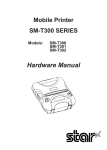
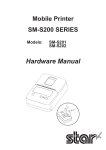
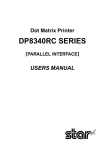
![User's Manual DP8340II SERIES [Serial]](http://vs1.manualzilla.com/store/data/006863352_1-7c329c58d43827994f443f796586090a-150x150.png)
![User`s Manual DP8340II R SERIES [Serial]](http://vs1.manualzilla.com/store/data/005993516_1-f706d7540b19c5fecea062c6335f03cc-150x150.png)

